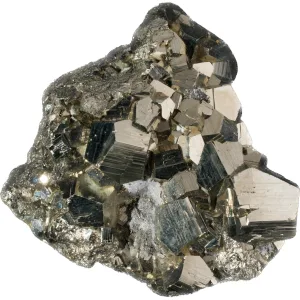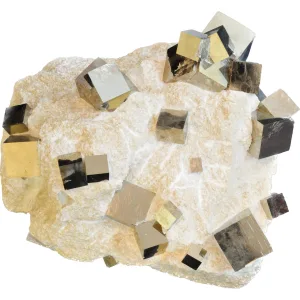Pyrite, also known as “fool’s gold,” is a widely recognized sulfide mineral renowned for its metallic luster and brassy-yellow color. It crystallizes in the cubic crystal system, often forming cubic or pyritohedral crystals with striations or cubic faces.
Spanish pyrite cubes are a unique variety found primarily in the coal mines of northern Spain, particularly in the Asturias region. These specimens consist of perfect to near-perfect cubic crystals embedded within limestone matrix. The pyrite cubes create striking geometric patterns within the rock, and they are highly prized by collectors for their exceptional clarity, geometric perfection, and the contrast between the brassy-yellow pyrite and the surrounding limestone.
Pyrite clusters from Peru are another notable variety known for their exceptional quality and large crystal formations. Pyrite specimens from Peru are often found in association with other minerals such as quartz and fluorite, forming impressive clusters and specimens. The Huanzala Mine and the Quiruvilca Mine in Peru are renowned for producing high-quality pyrite clusters with well-defined cubic crystals and vibrant metallic luster.
Pyrite has diverse applications beyond its use as a mineral specimen. It is a significant source of sulfur and is often mined for sulfur production. Additionally, pyrite is used in the production of sulfuric acid, in the manufacturing of batteries, and as a decorative stone in jewelry and ornamental objects.
Metaphysically, pyrite is believed to possess protective and grounding properties. It is associated with vitality, confidence, and manifestation, making it a popular stone in crystal healing and spiritual practices. Overall, pyrite’s captivating appearance, diverse formations, and metaphysical significance make it a highly valued mineral among collectors and enthusiasts worldwide.


